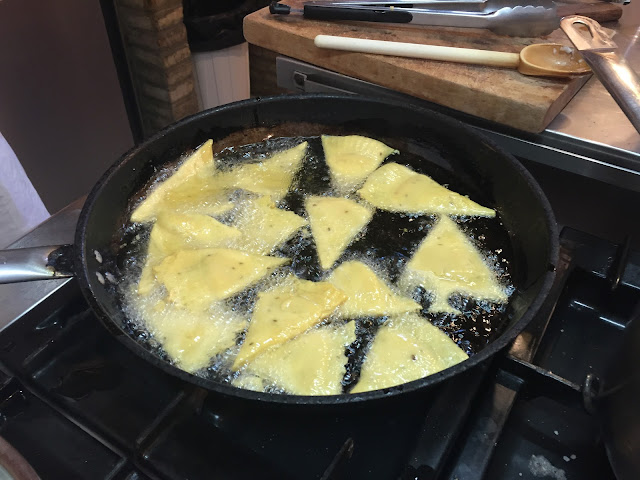The drive through the countryside approaching the farm – located near the center of the island of Sicily – was a visual delight (albeit a challenge to navigate and drive simultaneously, but fear not, there’s a train that runs nearby). Lush green fields and acre upon acre of vineyards were spread out before me, welcoming me as Springtime in Sicily laid out its thick green carpet.
Arriving at the farm, one is struck not only by the landscape, but also by the beauty of all the doors and woodwork painted in a vivid royal blue.
Sheep (if you’ve read this, you know how much I love sheep) and cheese we ate from the milk of these animals.
At that point, it will be easy to peel the solidified mixture off the plate. Stack them one on top of the other and slice into triangles.
Then fry them until they pop up and are golden brown.Drain on paper towels, sprinkle a little salt over the top, and watch them disappear. Do follow me down the road for future posts about this magical place and the some of the dishes I cooked and ate there, including cavatelli, cannoli, cassata and a most unusual eggplant rolatini. All the ingredients we ate and cooked with (including the almonds, pistachios and citrus fruits) were either grown on the farm or nearby.
Do follow me down the road for future posts about this magical place and the some of the dishes I cooked and ate there, including cavatelli, cannoli, cassata and a most unusual eggplant rolatini. All the ingredients we ate and cooked with (including the almonds, pistachios and citrus fruits) were either grown on the farm or nearby.And I promise to post more frequently. I’ve had computer glitches since returning. But all those frustrating hours spent with tech support on the phone are forgotten when I look at this serene path leading from Case Vecchie, a never ending source of inspiration.
Panelle from Case Vecchie- 4 cups (250 grams) chick pea flour
- 3 cups (750 ml) cold water
- pinch of salt
- pinch of freshly ground black pepper
- 1 Tablespoon fennel seeds (optional)
- Combine the flour, water, salt, pepper and fennel seeds in a medium sized pan and whisk until smooth.
- Cook over medium high heat, whisking constantly, until mixture is like a very stiff polenta.
- Lower the heat if necessary to keep from burning.
- Cook for a few more minutes, stirring with a wooden spoon, until the mixture pulls away from the sides of the pan.
- Working quickly, spread the mixture with a wooden spatula onto plates so that it is about 1/4 inch (0,5 mm) thick.
- Let sit until cool, 15 to 20 minutes.
- when dough is cool, loosen the edges with a knife and peel the “crepes” off the plates and place on a work surface, stacking one on top of the other.
- Cut stack into 16 wedges.
- In a large frying pan, heat 2 inches (5 cm) of oil until hot.
- Place wedges of chick pea mixture into hot oil and fry, flipping occasionally, until golden and crisp, about three minutes.
- Dry on paper towels and sprinkle with salt.
- Continue frying remaining wedges and serve hot.

















No comments:
Post a Comment